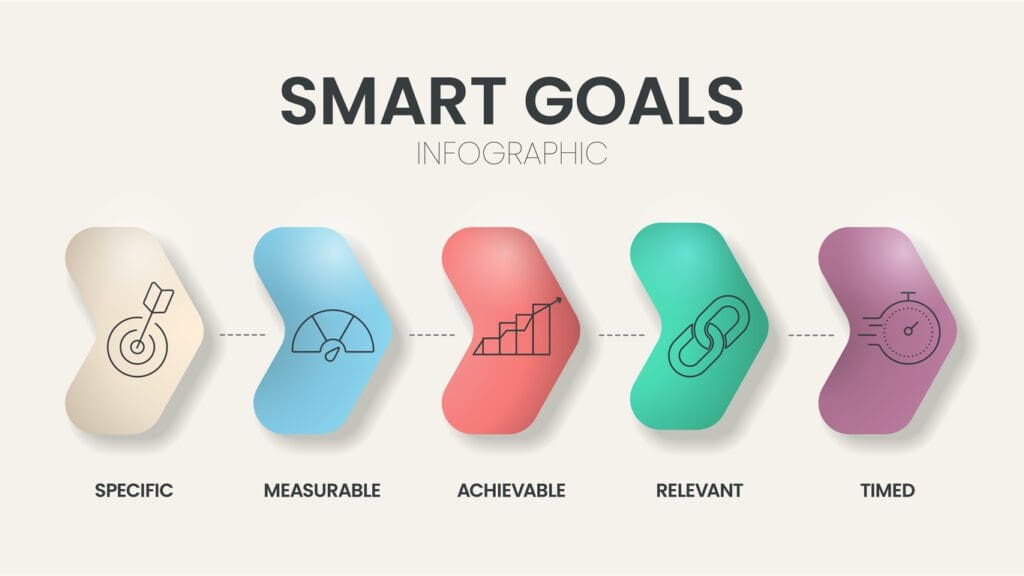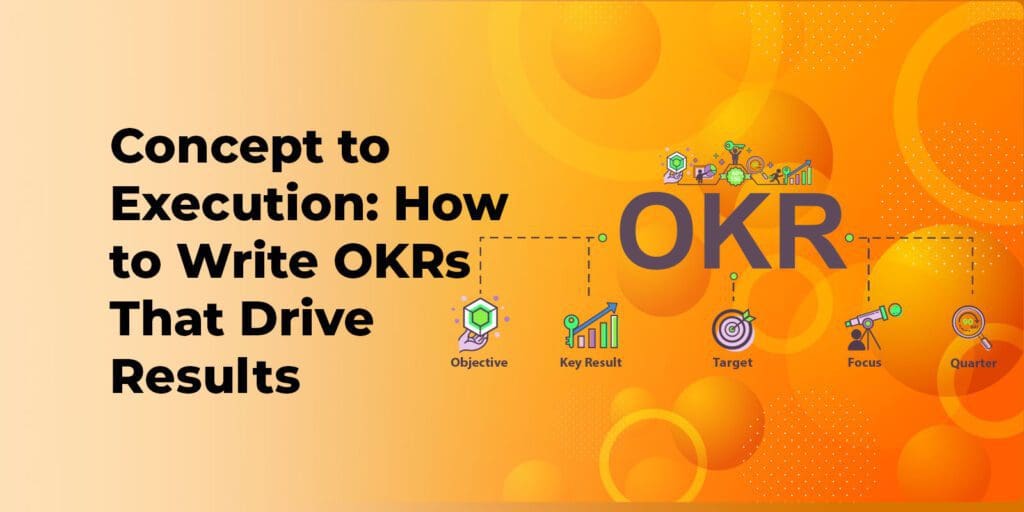Table of Contents
The Game-Changing Goal-Setting Framework You Must Try
mplementing OKRs successfully depends on knowing how to write them. Why? Because the long-term success of your goals could be affected by the quality of your OKRs.
This post will discuss the writing of OKRs and how to create them effectively.
A goal-setting framework called OKRs, or Objectives and Key Results can assist firms in formulating successful goals that produce outcomes.
Understanding the OKR Framework
Objectives and key outcomes are the two components of quarterly established OKRs. Key results are measurable assessments of your progress towards your objectives, whereas objectives are qualitative statements of what you hope to accomplish.
OKRs are a well-liked framework for creating goals because they are easy to use, adaptable, and scalable. They might be utilised by one person, a team, or a full organisation. OKRs are also open and collaborative, which can support an organisation’s efforts to foster trust and cohesion.
As companies look for ways to enhance performance and stay ahead of the competition in 2023, OKRs are anticipated to become even more common
Why use OKRs?
There are many benefits to using OKRs, including:
- Alignment: OKRs can help teams stay aligned by providing a common set of goals for everyone to work towards.
- Focus: OKRs can help teams focus on the most important goals by providing a clear roadmap for achieving success.
- Motivation: OKRs can help teams stay motivated by providing a sense of purpose and direction.
- Transparency: OKRs can help teams be more transparent by making goals and progress visible to everyone.
Additionally,
- Set demanding objectives: OKRs should be demanding yet doable. This will motivate your team and spur action.
- Divide goals into major outcomes: Key outcomes must be precise, measurable, doable, pertinent, and time-bound. They should be used to monitor your goals’ progress.
- Follow your growth: Review your progress frequently, and adjust as necessary. You can do this to keep on track and accomplish your objectives.
- Celebrate your accomplishments: When you reach your objectives, do so! This will encourage and maintain the interest of your employees.
Why is Writing Good OKRs Important?
Writing successful OKRs is vital because it ensures that your team is on the same page with your objectives and that you have a clear strategy for achieving them.
Setting Objectives and Key Results
When setting objectives and key results, it’s important to be high-level, time-bound, and measurable. Being high-level means that the objectives should focus on the bigger picture rather than specific tasks or activities. Being time-bound means that the goals should have a particular deadline or time frame associated with them. Being measurable means that the objectives and key results should be specific and quantifiable.
For example, a good objective might be to increase sales revenue by 20% in the next quarter. The key results might include the following:
- Metrics like the number of new customers acquired.
- The average order value.
- The conversion rate from leads to sales.
How to Write Objectives? – Examples and Best Practices
Specific, tangible, attainable, pertinent, and time-bound goals should be set. They ought to be both aspirational and grounded in reality. Avoid using general phrases and active verbs. Divide your plan into smaller, easier-to-handle steps. Obtain the views of others.
Writing effective objectives is crucial to the success of any OKR framework. Here are some examples and best practices for writing effective objectives:
- Make objectives ambitious but achievable. Objectives should be ambitious enough to motivate team members but still achievable.
- Align objectives with the company’s overall strategy. Objectives should align with the company’s comprehensive approach to ensure everyone is working towards the same goal.
- Make your key results specific, measurable, attainable, relevant, and time-bound (SMART): Your key results should be specific, measurable, attainable, relevant, and time-bound. This will help you track your progress and make sure you are on track to achieve your objectives.
- Use action-oriented language. Objectives should be written in action-oriented language to help team members understand what they need to do to achieve the objective.
- Involve your team in the process: To make sure that everyone is on the same page and that the goals are in line with the team’s strengths and weaknesses, involve your team in the process of setting OKRs.
- Keep objectives simple and easy to understand. Objectives should be simple and easy to understand to ensure everyone knows what they are working towards.
How to Write Key Results? – Examples and Best Practices
Writing effective key results is also crucial to the success of any OKR framework. Here are some examples and best practices for writing effective key results:
- Make key results specific and measurable. Key results should be clear and measurable to help team members focus on achieving the most important results.
- Set key results that are aligned with the objective. Key results should be aligned to ensure they contribute to the overall goal.
- Use metrics to measure success. Key results should be measurable using specific metrics to track progress and success.
- Set key results that are challenging but achievable. Key results should be challenging enough to motivate team members but still doable.
- Make key results time-bound. Key results should be time-bound to help team members focus on achieving the most important results within a specific timeframe.
Examples of OKRs
Here are some examples of OKRs:
Objective 1
Increase website traffic by 20% in the next quarter.
Key Results:
Increase the number of unique visitors to the website by 15%.
Increase the average time spent on the website by 5%.
Increase the bounce rate by 5%.
Objective 2
Launch a new product by the end of the year.
Key Results:
Complete the product development process by the end of the third quarter.
Get the product to market by the end of the fourth quarter.
Generate $1 million in revenue from the new product in the first year
Tips for Writing Effective OKRs
- Make sure that your goals are challenging but doable: You want to set objectives that will stretch your team but are still doable.
- Make significant results out of your aims: Specific, measurable, realistic, pertinent, and time-bound key results are required.
- Ensure that the general objectives of your business and your OKRs are compatible. Your company’s objectives must be reflected in your OKRs.
- Review your OKRs regularly and adjust as necessary. Your OKRs may need to modify as your business develops and changes.
- Celebrate your accomplishments!: Take the time to recognise the efforts of your team when you meet your OKRs. This will encourage them to continue working hard and accomplish even bigger feats.
How to Write Individual OKRs?
Individual OKRs should be aligned with the organisation’s overall goals, focussing on individual’s strengths and weaknesses. When writing individual OKRs, ensure that the objectives are challenging and that the individual is motivated to achieve them.
Some tips for writing individual OKRs include setting objectives aligned with the individual’s strengths and focusing on professional development. For example, an individual might aim to improve their public speaking skills or learn a new programming language.
Writing Team OKRs
Team OKRs should align with the organisation’s overarching objectives but should also be concentrated on the team’s advantages and disadvantages. It’s crucial to include each team member in developing the group’s OKRs. This can aid in ensuring that everyone is on the same page and that goals align with the organisation’s overarching objectives.
Some tips for writing team OKRs include setting challenging but achievable objectives and focusing on collaboration and teamwork. For instance, a team might decide to create a new product or service or work on improving teamwork and communication.


Involving Team Members in Setting Objectives
Including team members in the process of creating goals can help ensure that everyone is on the same page and that the goals align with the organisation’s broader objectives. When involving team members in setting objectives, providing them with the necessary information and resources is important. This can guarantee that everyone is fully aware of their responsibilities and how they can contribute to the organisation’s success.
Using Customer Satisfaction to Measure Success
Using customer satisfaction to measure success can provide valuable insights into how well the organisation is meeting the needs of its customers. This can help identify areas for improvement and ensure that the organisation offers a high level of customer service.
When using customer satisfaction to measure success, it’s important to use a reliable and valid measurement tool. This helps ensure that the results are accurate and meaningful.
Achieving the Bigger Picture with OKRs
Achieving the bigger picture with OKRs means setting objectives aligned with the organisation’s long-term goals. This helps ensure that everyone is working towards the same goals and that resources are effectively used.
It’s crucial to involve every employee in the process of defining goals that are in line with the organisation’s long-term objectives. This can help ensure everyone is on the same page and that objectives are achievable.
Other Goal-Setting Frameworks to Consider
While OKRs are a popular goal-setting framework, there are other frameworks that businesses can consider. Some of these frameworks include SMART goals, BHAGs, and KPIs. It’s critical to select the framework that best meets the company’s demands because every framework has strengths and shortcomings of its own.


Conclusion
In conclusion, writing good OKRs is important for driving results and ensuring everyone in the organisation is working towards the same objectives. When setting goals and key developments, it’s important to be high-level, time-bound, and measurable.
Involving team members in the process and using customer satisfaction to measure success can also help ensure that objectives are achievable and aligned with the organisation’s overall goals. Businesses can create effective OKRs that drive results and achieve the larger goal by adhering to these guidelines and avoiding frequent pitfalls.
Now that you know how to write effective OKRs, it’s time to put your knowledge into practice.
Sign up for free to execute your goal-planning strategies starting today!
FAQs
How can useful key results be written for OKRs?
Ensure that they’re time-bound, meaningful, quantifiable, and doable. Use measures that are precise and measurable. Avoid using ambiguous language. Reduce to more manageable steps. Get opinions.
What are OKR tools?
Teams and companies may establish, track, and manage their OKRs using software solutions known as OKR tools. These tools can aid in streamlining the OKR procedure, making it simpler to create objectives, monitor advancement, and maintain focus.
What are the few frequent mistakes done when developing OKRs?
There are a few errors you can try to avoid. The most significant one is having too many priorities that inhibit everyone on your team from seeing the way forward.



